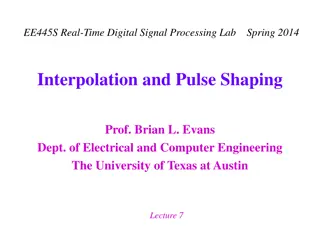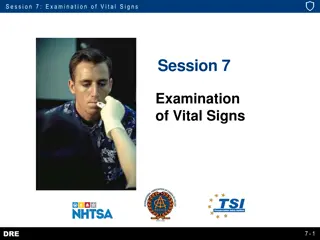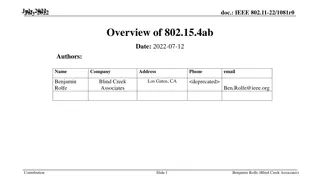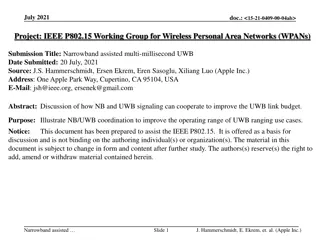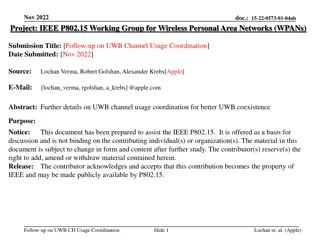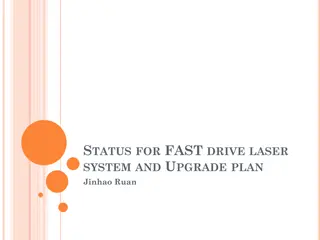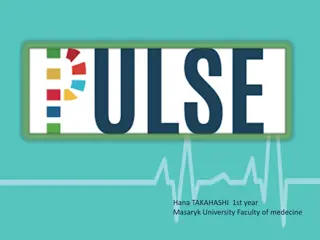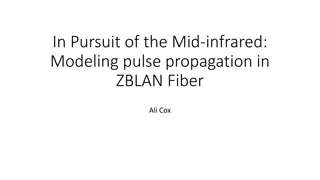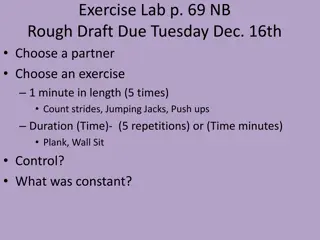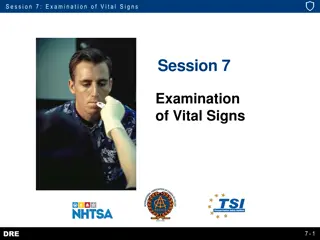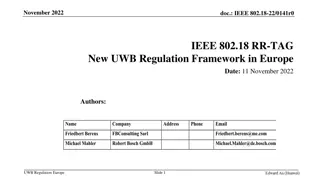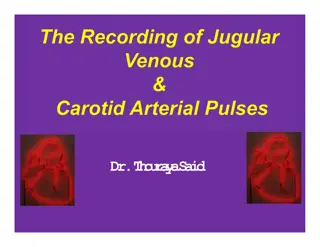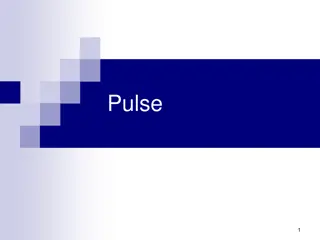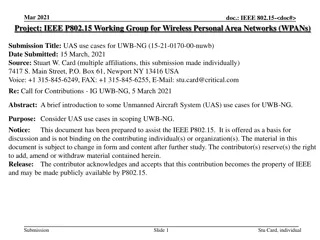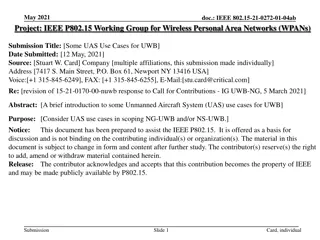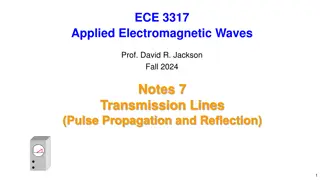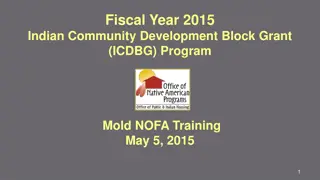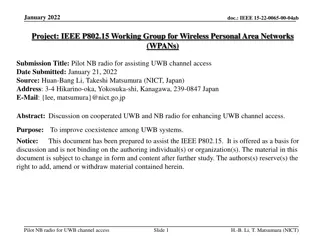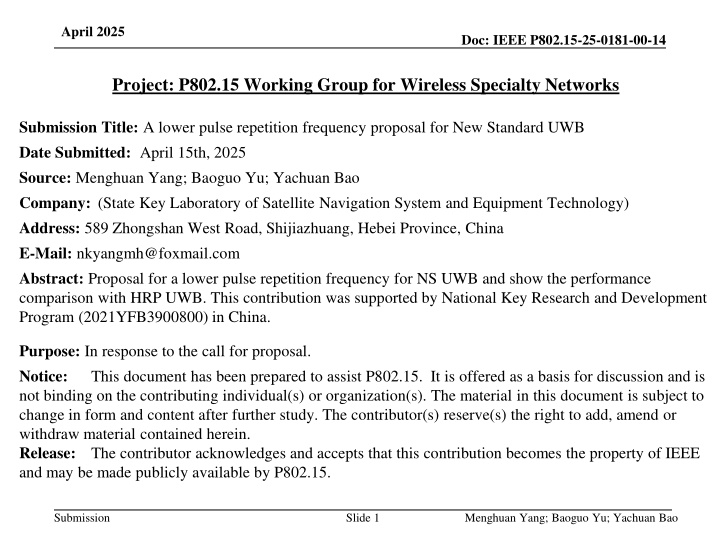
Enhancing Ranging Capability in NS-UWB Proposal
This proposal discusses a lower pulse repetition frequency for NS-UWB to enhance ranging capability, improve link budget, and reduce receiver complexity. Supported by the National Key Research and Development Program in China, the submission aims to contribute to the New Standard UWB specifications for wireless ad hoc connectivity with precision ranging capabilities.
Uploaded on | 2 Views
Download Presentation

Please find below an Image/Link to download the presentation.
The content on the website is provided AS IS for your information and personal use only. It may not be sold, licensed, or shared on other websites without obtaining consent from the author. If you encounter any issues during the download, it is possible that the publisher has removed the file from their server.
You are allowed to download the files provided on this website for personal or commercial use, subject to the condition that they are used lawfully. All files are the property of their respective owners.
The content on the website is provided AS IS for your information and personal use only. It may not be sold, licensed, or shared on other websites without obtaining consent from the author.
E N D
Presentation Transcript
April 2025 Doc: IEEE P802.15-25-0181-00-14 Project: P802.15 Working Group for Wireless Specialty Networks Submission Title: A lower pulse repetition frequency proposal for New Standard UWB Date Submitted: April 15th, 2025 Source: Menghuan Yang; Baoguo Yu; Yachuan Bao Company: (State Key Laboratory of Satellite Navigation System and Equipment Technology) Address: 589 Zhongshan West Road, Shijiazhuang, Hebei Province, China E-Mail: nkyangmh@foxmail.com Abstract: Proposal for a lower pulse repetition frequency for NS UWB and show the performance comparison with HRP UWB. This contribution was supported by National Key Research and Development Program (2021YFB3900800) in China. Purpose: In response to the call for proposal. Notice: This document has been prepared to assist P802.15. It is offered as a basis for discussion and is not binding on the contributing individual(s) or organization(s). The material in this document is subject to change in form and content after further study. The contributor(s) reserve(s) the right to add, amend or withdraw material contained herein. Release: The contributor acknowledges and accepts that this contribution becomes the property of IEEE and may be made publicly available by P802.15. Submission Slide 1 Menghuan Yang; Baoguo Yu; Yachuan Bao
April 2025 Doc: IEEE P802.15-25-0181-00-14 A Lower pulse repetition frequency Proposal for NS-UWB Menghuan Yang; Baoguo Yu; Yachuan Bao State Key Laboratory of Satellite Navigation System and Equipment Technology (SKL-SatNav) Submission Slide 2 Menghuan Yang; Baoguo Yu; Yachuan Bao
April 2025 Doc: IEEE P802.15-25-0181-00-14 Background IEEE Std 802.15.4 is overly complex and has become extremely difficult to understand, amend or enhance. The PAR&CSD for New Standard UWB have been approved by IEEE 802 EC DCN:15-21-0278 & 15-21-0274 The New Standard UWB specifies the PHY and MAC layer for impulse radio ultra wideband (UWB) wireless ad hoc connectivity with fixed, portable, and moving devices with limited energy consumption requirements, and supports real time precision ranging capability that is accurate to within a few centimeters. Submission Slide 3 Menghuan Yang; Baoguo Yu; Yachuan Bao
April 2025 Doc: IEEE P802.15-25-0181-00-14 Motivations For the NS-UWB, the primary focus on the physical layer should be the improvement of the ranging ability for higher precision ranging or longer-range coverage, particularly in dense multipath environment. Trade off between ranging and communication Trade off between pilot and data The New Standard UWB specifies the PHY and MAC layer for impulse radio ultra wideband (UWB) wireless ad hoc connectivity with fixed, portable, and moving devices with limited energy consumption requirements, and supports real time precision ranging capability that is accurate to within a few centimeters. In this contribution, we propose a lower pulse repetition frequency (PRF) to enhance accurate ranging capability, improve link budget, and reduce receiver complexity. Submission Slide 4 Menghuan Yang; Baoguo Yu; Yachuan Bao
April 2025 Doc: IEEE P802.15-25-0181-00-14 Why a lower PRF? A lower Pulse repetition frequency (PRF) is desirable as it helps with: Reducing the inter pulse interference Improve the link budget Low complexity incoherent reception Submission Slide 5 Menghuan Yang; Baoguo Yu; Yachuan Bao
April 2025 Doc: IEEE P802.15-25-0181-00-14 Inter pulse interference in dense multipath In dense multipath environment, the NLOS signal of the previous pulse may superimpose onto LOS signal of current pulse, resulting in false detection of LOS signal. A lower pulse repetition frequency leads to a larger pulse interval, reducing the probability of inter pulse interference. High repetition pulse Lower repetition pulse Submission Slide 6 Menghuan Yang; Baoguo Yu; Yachuan Bao
April 2025 Doc: IEEE P802.15-25-0181-00-14 PDP in dense multipath In dense multipath environment, the multipath delay could be over 1000ns under extreme conditions. Assuming that when the energy of multipath signals exceeds - 20dB, it will have a significant impact on the determination of the direct path. The Ref IEEE 802.15.4a channel model- final report (DCN:#15-04-0662) Submission Slide 7 Menghuan Yang; Baoguo Yu; Yachuan Bao
April 2025 Doc: IEEE P802.15-25-0181-00-14 Mean & Max E.I.R.P The regulatory authorities (FCC, MIIT, CEPT, etc.) have constituted UWB emission limits on Mean EIRP and max EIRP. The Mean EIRP should be less than -41.3dBm/MHz, and the max EIRP should be less than 0dBm/MHz. Submission Slide 8 Menghuan Yang; Baoguo Yu; Yachuan Bao
April 2025 Doc: IEEE P802.15-25-0181-00-14 Link budget TX HRP 62.4MHz 64 4096 65.128us 8 4*64 8.141us 0.85 21*64 21.538us 6.81 (112+48)*8 20.513us 6976 115.32us HNav 918KHz 128 128 RX HRP HNav PRF N sym in SFD 8 1 N symbol N pulse Time N symbol N pulse Time Data rate N pulse Time Data rate N pulse Time N pulse Time Energy pulse N pulse per symbol 32 64 SYNC Nominal processing gain 3.01dB 2.25dB 64 64 15.05dB 13.5dB Processing gain SFD 19.8pJ 913pJ Engrgy per symbol 0.459 224 96.5dB 113dB Receiver SNR PHR threshold 10dB 10dB Noise Figure 5dB 5dB PSDU Quantization noise 5dB 416 Link budget 81.5dB 93dB 453.33us Total per 71.1m 267m Distance(@3993.6MHz) 0.62pJ 40.8pJ Submission Slide 9 Menghuan Yang; Baoguo Yu; Yachuan Bao
April 2025 Doc: IEEE P802.15-25-0181-00-14 Simulation: Charactstic Under the constraint of E.I.R.P., the lower the PRF, the larger the amplitude of the pulse, and the stronger the anti-interference ability. Submission Slide 10 Menghuan Yang; Baoguo Yu; Yachuan Bao
April 2025 Doc: IEEE P802.15-25-0181-00-14 Simulation: Coverage The distance between the receiver and the transmitter is 100 meters When PRF = 62.4MHz, the signal cannot be detected through the correlation peak. Submission Slide 11 Menghuan Yang; Baoguo Yu; Yachuan Bao
April 2025 Doc: IEEE P802.15-25-0181-00-14 Simulation: Coverage The distance between the receiver and the transmitter is 100 meters When PRF = 918KHz, the signal can be detected through the correlation peak. Submission Slide 12 Menghuan Yang; Baoguo Yu; Yachuan Bao
April 2025 Doc: IEEE P802.15-25-0181-00-14 Simulation: Ranging in Dense multipath In typical indoor multipath scenarios, using ray tracing for channel modeling Submission Slide 13 Menghuan Yang; Baoguo Yu; Yachuan Bao
April 2025 Doc: IEEE P802.15-25-0181-00-14 Simulation: Ranging in Dense multipath When PRF = 62.4MHz, the ranging error is 0.21 meter(1 ) When PRF = 918KHz, the ranging error is 0.058 meter(1 ). Submission Slide 14 Menghuan Yang; Baoguo Yu; Yachuan Bao
April 2025 Doc: IEEE P802.15-25-0181-00-14 Simulation: AoA in Dense multipath When PRF = 62.4MHz, the Angle of Arrival error is 0.21 meter(1 ) When PRF = 918KHz, the Angle of Arrival error is 0.058 meter(1 ). Submission Slide 15 Menghuan Yang; Baoguo Yu; Yachuan Bao
April 2025 Doc: IEEE P802.15-25-0181-00-14 Underground Trail We conducted field tests in an underground environment using two different devices, one with a PRF of 62.4MHz and the other with a PRF of 918KHz. Submission Slide 16 Menghuan Yang; Baoguo Yu; Yachuan Bao
April 2025 Doc: IEEE P802.15-25-0181-00-14 Underground Trail The transmission power of two sets of devices has been adjusted to similar values, one is 1.51dBm PRF=62.4MHz and the other is 1.48dBm PRF = 918KHz When PRF = 62.4MHz, the maximum coverage distance is about 470meters When PRF = 918KHz, the maximum coverage distance is about 768meters. Submission Slide 17 Menghuan Yang; Baoguo Yu; Yachuan Bao
April 2025 Doc: IEEE P802.15-25-0181-00-14 Conclusion In this contribution, we propose a lower pulse repetition frequency (PRF) to enhance accurate ranging capability in dense multipath environment. The simulation results show the lower PRF is better with more coverage and higher measurement accuracy Field testing further confirmed the above viewpoint, especially when the mean E.I.R.P. is equal. Submission Slide 18 Menghuan Yang; Baoguo Yu; Yachuan Bao
April 2025 Doc: IEEE P802.15-25-0181-00-14 Thank you! Submission Slide 19 Menghuan Yang; Baoguo Yu; Yachuan Bao

